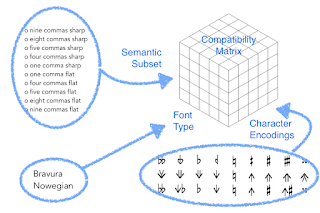There is a push within the W3C (World Wide Web Consortium, an international community that develops open standards to ensure the long-term growth of the Web) to "bring music notation to the web". While clearly invigorating to the music programming community, it throws up a number of compatibility and other issues. We try to identify a few.
Big, brave, open-source, non-profit, community-provisioned, cross-cultural and padded cell crazy. → Like, share, back-link, pin, tweet and mail. Hashtags? For the crowdfunding: #VisualFutureOfMusic. For the future live platform: #WorldMusicInstrumentsAndTheory. Or simply register as a potential crowdfunder..
Music Notation Standardisation for the Web
 |
Microtonal Notations Are Gaining Traction
(Here: Sagittal) |
Supporting this are new standards built around the exchange format MusicXML, and notation naming and layout in the form of SMuFL (Standard Music Font Layout). There is, however, an enormous amount of lot of work to be done in aligning these two standards if they are to work together seamlessly.
Though not directly mentioned, a number of other, supporting standards are involved.
These cover underlying or related technologies such as XML and (for notation) SVG, web media, and in particular, audio.
<
Music Fonts
 First off, if interested in music fonts in general, you might like to take a look at this page - the list is huge, but be aware that not all of these are web standards compliant.
First off, if interested in music fonts in general, you might like to take a look at this page - the list is huge, but be aware that not all of these are web standards compliant.
SMuFL Compliant Fonts
SMuFL: 'Standard Music Font Layout'. A small range of SMuFL-compliant fonts are already in existence, chief among these:
MusicXML Transformation
Currently there are two main paths towards MusicXML transformation in the browser, the at first glance somewhat intimidating and specification-oriented route (a combination xslt, xsd, xcode and xsl stylesheets), the second a more test-oriented MusicXML parser approach, ultimately manipulating CSS and SVG directly in the DOM.
In practice, with data-driven visualization techniques musical emancipation in the browser, quality data visualization libraries such as D3.js can augment or entirely replace these with the informal and visual prototype in the browser approach, a data-driven paradigm and hence algorithmic glyph (musical character) positioning. With data having become so closely integrated with the browser DOM, visual feedback on the success or failure of a line of code is often immediately available.
Part of the drive within the MusicXML group at WC3 is a move from the widely used Partwise to the less prevalent Timewise MusicXML structuring approach. The variety of end results using even existing Partwise layouts reveal how much interpretive ambiguity remains.
 |
| Algorithmic Positioning? |
Currently, MusicXML supports vendor-specific glyph positioning information, yet it can be argued that this has no place in what is effectively a data transfer protocol. With modern data visualisation libraries supporting algorithmic positioning by default, this information is, in effect, superfluous.
 |
| MusicXML conversion tools |
Moreover, from a developer perspective, traversal of MusicXML’s Partwise syntax does not auger naturally with data-driven programming techniques.
Tools (xsl stylesheets) are, however, available to convert from partwise to timewise and vice-versa.
For further font ideas, you could do worse than to look at this collection of music fonts, presented by Matthew Hindson
Alternate Tunings
Alternate tunings enjoy quite some popularity amongst players of stringed instruments, yet those widely represented on the internet are for the most part based on our conventional, 12-tone, equal temperament system.
Yet even within 12TET, some instruments have a history of use in many different tunings. Those for guitar, 5-string banjo or bouzouki, for example, can number hundreds.
Often developed to support particular playing styles, these remain a rich source for experiment and stylistic individuality.
Alternate Temperaments and Intonations
Not only are there many other equal temperament systems in use worldwide, but there are also entire constellations of tunings in so-callee 'just', 'rational' or 'fractional' intonations. Some were central to music prior to the adoption of equal temperament.
Some music industry voices claim that as a result of advances in digital music processing (especially soundfonts), rational (as opposed to equal temperament) tunings are set to enjoy a renaissance.
This is indeed an intriguing thought. "Modern musicians, having grown up hearing nothing but 12-ET, who are introduced to a more consonant tuning (such as the meantone temperament) for even a very short time almost invariably find it shocking to discover how jarring or restless the triads of 12-ET sound by comparison." (Taken from "Gift of the Gods").
Wherever we deviate from the 12-tone, classical or western music system, we need a means of expressing these alternate notes.
Seen in a worldwide context, musical diversity is under significant threat from the 12TET or 12EDO music system, but also from industrialised or factory music production methods. The resulting cultural loss affects us all.
Can new notations breath fresh life into heritage music systems?
The Music Notation Project, which documents alternative notations, maintains a set of notation adoption criteria.
Though it does not appear to have explored microtonal systems, this project studied a wide range of alternative music notations over many years with the goal of identifying candidates for wider adoption.
Sagittal Microtonal Notation
The Sagittal notation system, however, allows the symbolic representation of musical pitch across all possible scales and tunings - and that within the confines of the western musical staff. This is a universal set of microtonal accidentals, equally suited to extended just intonation, equal divisions of the octave (or of any other interval), or any of the non-just non-equal "middle path" tunings or temperaments.
There are other symbol systems for microtonal music, but the Sagittal system distinguishes itself in several respects: o a community product o adopted for use within SMuFL o suited both to equal (eg 12TET) and rational (eg Just Intonation) systems.
o the version 3 mapping of Steinberg's free Bravura font contains (among many others) the Sagittal symbols.
One of the advantages of a data-driven system is, however, that alternative notations can -where available- be offered, even piecemeal. Until Saggital takes hold, existing and possibly more widely recognised microtonal notations can continue to find use.
Current Aggregator Platform Notation
The world music aggregator platform at the focus of this blog currently uses the Gonville font by Simon Tatham. Gonville was chosen simply as it was free, copyright-free, and sufficiently expressive to serve initial, proof-of-concept needs.
It was clear that amigration to an SVG font (for standards conformity and greater expressive range) would be necessary in the long run.
As with many aspects of this project, technical advances eventually caught up with our needs, in this case in the form of SMuFL, Bravura and especially it's Sagittal extension.
It goes without saying that in the context of our world music aggregator platform, any future fonts adopted will need to support the Sagittal or similar microtonal symbols.
Instrument Fingering Fonts
 Though well established for certain string instruments such as guitar, fonts (including tablature) showing fingerings for specific instruments such as recorder, saxophone or clarinet in diagrammatic form are gaining traction.
Though well established for certain string instruments such as guitar, fonts (including tablature) showing fingerings for specific instruments such as recorder, saxophone or clarinet in diagrammatic form are gaining traction.
As wind instrument fingerings are many to one (a n:1 relationship), they are best located directly above the notation's associated part or voice.
These are generally valid only for 'standard' instruments fingerings. As such they are no substitute for fully configurable instrument models allowing any tuning or fingering layout.
Font Use In The Aggregator Platform Context
The future lies in the following:
- Free choice of SVG font
- Font preferences saveable
- Microtonal characters (glyphs)
- Some form of font compatibility matrix (implied by the first two list items)
To get there, we need to think about font / meaning / glyph mappings:

Music Font Compatibility Matrix
Multiple glyphs may map to the same musical direction - even within the same font. It should be clear that any retrieval needs to be done on the basis of glyph code, and not position :-)
Further Information
There are a couple of follow-on posts to this topic, beginning here.
For further information relevant to notation, try this forum.
Keywords
online music learning,
online music lessons
|
distance music learning,
distance music lessons
|
remote music lessons,
remote music learning
|
p2p music lessons,
p2p music learning
|
music visualisation
music visualization
|
musical instrument models
interactive music instrument models
|
music theory tools
musical theory
|
p2p music interworking
p2p musical interworking
|
comparative musicology
ethnomusicology
|
world music
international music |
folk music
traditional music
|
P2P musical interworking,
Peer-to-peer musical interworking
|
WebGL, Web3D,
WebVR, WebAR
|
Virtual Reality,
Augmented or Mixed Reality
|
Artificial Intelligence,
Machine Learning
|
Scalar Vector Graphics,
SVG
|
3D Cascading Style Sheets,
CSS3D
|
X3Dom,
XML3D
|

 First off, if interested in music fonts in general, you might like to take a look at this page - the list is huge, but be aware that not all of these are web standards compliant.
First off, if interested in music fonts in general, you might like to take a look at this page - the list is huge, but be aware that not all of these are web standards compliant.






 Though well established for certain string instruments such as guitar, fonts (including tablature) showing fingerings for specific instruments such as recorder, saxophone or clarinet in diagrammatic form are gaining traction.
Though well established for certain string instruments such as guitar, fonts (including tablature) showing fingerings for specific instruments such as recorder, saxophone or clarinet in diagrammatic form are gaining traction.



Comments, questions and (especially) critique welcome.